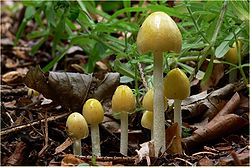Differences in genera
Bolbitius are mushrooms which are thin, Mycena -like, with gelatinous cap surface. These lack a veil, are saprotrophic, and tend to be found with grass.
Conocybe are mushrooms which are thin, Mycena-like, with a dry cap surface. These are small and saprotrophic, and tend to be found with grass. These have cheilocystidia which are capitate.
Pholiotina are mushrooms which are thin, Mycena-like, with a dry cap surface. These are small and saprotrophic, and tend to be found with grass, and have a veil. Some have a membranous veil, mid-stipe, others the veil breaks up and can be found on the cap margin. These are separated from Conocybe in that the cheilocystidia are non-capitate.
Descolea includes Pholiotina-like mushrooms that are ectomycorrhizal and have limoniform spores. [1]
This page is based on this
Wikipedia article Text is available under the
CC BY-SA 4.0 license; additional terms may apply.
Images, videos and audio are available under their respective licenses.
